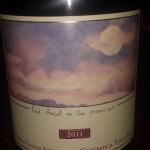As I noted in my very first post to this blog, one potential direction for my budding wine career is to develop an import portfolio featuring wines that one does not often see in the United States. The world of wine is wide and varied, and I am excited by opportunities to broaden the experience of the unique. These can be uncommon wines because they are made from varietals little known here, or are wines from better-known grapes that are grown in regions of the world that are not well represented in the American marketplace.
A few weeks ago, Julie and I met friends at one of our very favorite restaurants, Alana’s Food and Wine here in Columbus. In addition to Alana Shock, the chef-owner, having one of the most consistently creative kitchens we have ever had the pleasure to experience, I am also a very big fan of the wine list put together by her husband and partner, Kevin Bertschi.
In addition to a ten-selection by-the-glass service, the wine list at Alana’s features a significant and broadly-representative selection of wines. The list has well over 200 different wines, showcasing dozens of varietals from regions across the globe. The list is organized by varietal within the broad categories of sparkling, rosé, white and red, and includes the vintage for each wine.
The wines are priced as well or better than you will find in many restaurants. Alana’s also operates a retail wine shop; you can purchase wines there for off-premise consumption. The wines are priced at the state minimum retail price, which is the minimum price a retail establishment in Ohio is required by law to charge for a bottle of wine. As I discussed in my most recent post (New Orleans Shop W.I.N.O. Brings Wine to the People), restaurants and wine bars have additional overhead costs that are often offset by charging higher prices than a wine shop. Alana’s wines, by contrast, are priced at state minimum for to-go sales, and they add only a small corkage fee to have those same wines served to you on the premises.
The Wine
The menu that night had a number of dishes featuring mushrooms or truffles, so of course I was thinking old-world Pinot Noir.
Wine people talk about old world and new world wines. By old world, we mean European, regions where grape growing and wine making are thousands of years old, as opposed to most of the rest of the world where winemaking tradition is measured in hundreds of years. The old world/new world distinction also has a stylistic meaning. This is a very broad generalization, but because temperatures in old-world wine growing regions tend to be cooler than those in the rest of the wine-producing world, European grapes are comparatively less ripe making old-world wines comparatively more earthy and mineral than new-world wines, which tend to be more fruit driven. It was that earthiness I was thinking of pairing with our meals.
While perusing the wine list, I saw something I had not seen anywhere before, a Jermann Wines 2011 Red Angel on the Moonlight Pinot Nero from the region of Friuli Venezia-Gulia in the northeastern corner of Italy.
This wine was uncommon on a number of different levels. First, there is its classification in Italian wine law. Italian wine law is based on the French appellation d’origine contrôlée or AOC system. In Italy, it is the Denominazione di origine controllata or DOC system, meaning controlled designation of origin. Like the French law, the Italian strictly regulates the type of grapes, how they are grown and how the wines are produced and aged, all to ensure that wines bearing a DOC designation are high-quality representations of wines from that region.
Unlike French law, however, Italian wine law changed in 1992 with the creation of a new classification called Indicazione Geografica Tipica (IGT). The IGT classification was in response to winemakers in Italy producing extraordinary wines that did not meet the strict regulations of the DOC classifications. Often IGT wines contain different grapes than a DOC wine from the same area or the wines may be aged differently than a DOC wine. In the case of the Red Angel on the Moonlight, it was labeled Venezia-Giulia IGT, not with the Friuli Venezia-Giulia DOC classification that overlaps it geographically. It is the IGT classification that allows the winemaker to produce a classified Pinot Noir from that region.
Pinot Noir makes up a very small percentage of all grapes grown in Italy. Less than one percent of all acres under vine in Italy are dedicated to Pinot Noir, and much of that goes to sparkling wine. Within the region of Friuli Venezia-Giulia, a still, dry wine made from Pinot Noir is also uncommon. Ed McCarthy wrote in Wine Review Online that 73 percent of the wine produced in Friuli Venezia-Giulia is white, and in most of the articles I have seen on red grapes in the region, Pinot Noir rarely gets a mention.
Even for the winemaker, this wine is uncommon. Jermann is one of the larger winemakers in Friuli Venezia-Giulia. Gambero Rosso’s 2014 guide to Italian wines notes that Jermann’s annual production is about 900,000 bottles. The nearly 6,000 bottles of 2011 Red Angel on the Moonlight accounts for less than one percent of the winery’s total production.
In short, I had very little personal knowledge or experience to help me determine if this was a wine I should order, so how did I make that decision? If the restaurant you are visiting has a sommelier or wine steward, you should seek their assistance in selecting a wine. That night, I talked with Kevin about our possible food choices, the wine experience I was looking for, and I asked him to tell me about the 2011 Red Angel on the Moonlight.
The Judgment
Was it, in the end, the right choice? The answer for my palate, which favors old-world-styled wines, is an enthusiastic yes.
This wine is a pretty ruby color that fills the glass, but I was blown away by the earthy nose. This was serious Pinot Noir with some herbaceous notes and a hint of higher aromatics like rose petals. Hiding in the background was a little vanilla, indicative of some oak aging.
Some of the flexibility granted to winemakers in the IGT classification includes the authority to blend a small amount of other grapes with the main varietal listed on the label. This wine is 85 percent Pinot Noir with 15 percent Merlot and Cabernet Sauvignon. Not only do those grapes add to the complexity of the nose, but they bring additional nuances to the flavor profile as the wine transitions from the Pinot Noir-influenced sour cherry to more dark berry and plum. Those transitions and complexities are a significant part of what I find enjoyable about well-made wines. There is also a good acid component to this wine that brightens it and cleanses the palate, making it a great pairing with cheese or cream sauces, and that gives the wine a structural component that suggests it should age well over the next five to seven years.
On the negative side, I would have preferred it if this wine had a little more luscious mouth feel, just a little more density or weight. Most significantly, the finish is a little short. I wanted those beautiful mid-palate tones to linger a little longer.
On the whole this is a wonderful, old-world styled Pinot Noir, well-priced at $50. I would rate this wine 89-90 out of 100 or a very strong B+.

